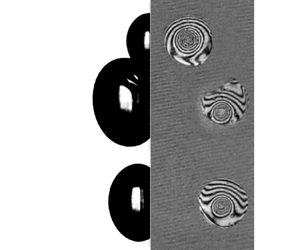Crossref Citations
This article has been cited by the following publications. This list is generated based on data provided by
Crossref.
Moiz, Mohd
Vadlamudi, Sai Raja Gopal
and
Srivastava, Atul
2023.
Experiments to understand microlayer and dry patch dynamics under subcooled nucleate flow boiling in a vertically oriented rectangular channel.
Physics of Fluids,
Vol. 35,
Issue. 4,
Moiz, Mohd
Sameer, Mohammed
and
Srivastava, Atul
2024.
Understanding the coupled dynamics of vapor bubble and microlayer on nanocoated varying wettability surfaces under nucleate flow boiling regime.
International Communications in Heat and Mass Transfer,
Vol. 159,
Issue. ,
p.
108160.
Li, Chaojie
Shen, Zongwang
Pan, Qingpeng
Duan, Jihai
and
Wang, Weiwen
2024.
Study on the effect of multiple bubbles hydrodynamics on pool boiling heat transfer.
International Journal of Multiphase Flow,
Vol. 174,
Issue. ,
p.
104792.
Hong, Heepyo
Ku, Ja Hyun
Kim, Jae Soon
and
Cho, Hyoung Kyu
2024.
Boiling heat flux partitioning model with bubble tracking method considering bubble merger and stochastic characteristics.
International Journal of Heat and Mass Transfer,
Vol. 226,
Issue. ,
p.
125443.
Zhang, Lenan
Iwata, Ryuichi
Lu, Zhengmao
Wang, Xuanjie
Díaz-Marín, Carlos D.
and
Zhong, Yang
2024.
Bridging Innovations of Phase Change Heat Transfer to Electrochemical Gas Evolution Reactions.
Chemical Reviews,
Vol. 124,
Issue. 17,
p.
10052.
Tsujimura, Ryoma
and
Okawa, Tomio
2024.
Interference effect of nearby nucleation sites on bubble release frequency in subcooled flow boiling.
Applied Thermal Engineering,
Vol. 247,
Issue. ,
p.
123078.
Moiz, Mohd
Vadlamudi, Sai Raja Gopal
and
Srivastava, Atul
2024.
Comprehensive experimental thermal analysis of single bubble nucleation in vertical flow boiling: Whole field temperature and microlayer dynamics.
International Journal of Heat and Mass Transfer,
Vol. 233,
Issue. ,
p.
126006.
Vadlamudi, Sai Raja Gopal
Moiz, Mohd
Srivastava, Atul
Hampel, Uwe
and
Ding, Wei
2024.
On the quantification of microlayer contribution toward bubble growth under subcooled flow boiling regime.
Physics of Fluids,
Vol. 36,
Issue. 9,
Huang, Haoxiang
Yu, Jialing
Yan, Zhe
and
Pan, Zhenhai
2024.
On interaction between a bubble with evaporation and heated pillar block in microchannel.
Physics of Fluids,
Vol. 36,
Issue. 3,
Wang, Shixian
Wang, Kai
Miwa, Shuichiro
Chen, Taishan
and
Okamoto, Koji
2024.
A dynamic characteristics on the boiling crisis in downward facing flow boiling, part I: Motion of the CHF front and factors investigation.
International Communications in Heat and Mass Transfer,
Vol. 159,
Issue. ,
p.
108035.
Moiz, Mohd
Sameer, Mohammed
and
Srivastava, Atul
2024.
Coupled vapor bubble and microlayer dynamics during nucleate flow boiling on nanocoated surfaces offering varying wettability
.
p.
1011.
Zhang, Jinming
Li, Rang
Vadlamudi, Sai Raja Gopal
Pang, Chi
Hampel, Uwe
and
Ding, Wei
2025.
Heat transfer enhancement for nucleate boiling via microlayer disruption on micro-pillar arrayed surfaces.
International Journal of Heat and Mass Transfer,
Vol. 241,
Issue. ,
p.
126770.
Qi, Run-Sheng
Li, Ya-Nan
and
Li, Zeng-Yao
2025.
A hydrodynamic model for the microlayer structure under heterogeneous bubbles in pool boiling.
Physics of Fluids,
Vol. 37,
Issue. 8,
Wang, Shixian
Wang, Kai
Zeng, Chen
Miwa, Shuichiro
and
Okamoto, Koji
2025.
A dynamic characteristic on the boiling crisis in downward facing flow boiling, Part II: Model development and validation.
International Communications in Heat and Mass Transfer,
Vol. 160,
Issue. ,
p.
108360.
Zhang, Xiao-Yu
Duan, Xin-Yue
Zhang, Tao
Xu, Ming-Hai
Sun, Shuyu
Gong, Liang
and
Liu, Lande
2025.
Model and algorithmic augmentation in phase field method for simulating the pool boiling phenomenon with high-density ratio.
Physics of Fluids,
Vol. 37,
Issue. 1,
Akbari, Mohammad Javad
Khedmati, Amir Reza
Bijarchi, Mohamad Ali
and
Shafii, Mohammad Behshad
2025.
Impact dynamics of a ferrofluid marble on surfaces under a vertical magnetic field: Pre-impact motion and maximum spreading.
Physics of Fluids,
Vol. 37,
Issue. 9,
Han, Jinyu
Gao, Deyang
Hao, Wenjie
Sun, Zhiyuan
Liu, Yao
He, Wen
Zhao, Chenru
and
Bo, Hanliang
2025.
Phase and thermal evolution in flow boiling: Theories and fundamental issues.
International Communications in Heat and Mass Transfer,
Vol. 168,
Issue. ,
p.
109415.
Moiz, Mohd
Prajapat, Rakhee
and
Srivastava, Atul
2025.
Prediction of bubble dynamics parameters in nucleate flow boiling using artificial neural networks (ANN).
International Communications in Heat and Mass Transfer,
Vol. 162,
Issue. ,
p.
108668.
Moiz, Mohd
Prajapat, Rakhee
Srivastava, Arpan
and
Srivastava, Atul
2025.
Machine learning-inspired study of dynamical parameters of single vapor bubble under nucleate flow boiling regime.
Applied Thermal Engineering,
Vol. 259,
Issue. ,
p.
124827.
Xiao, Mingkun
Huang, Yonghua
Yang, Guang
Li, Chunyu
Cai, Aifeng
and
Wu, Jingyi
2026.
Bubble detachment dynamics in cryogenic boiling under microgravity: Experiments and empirical models.
International Journal of Heat and Mass Transfer,
Vol. 256,
Issue. ,
p.
127915.



